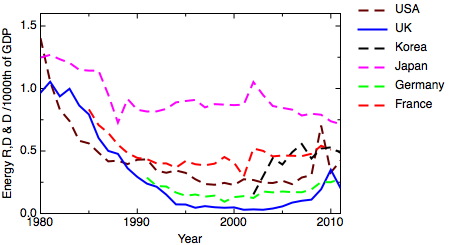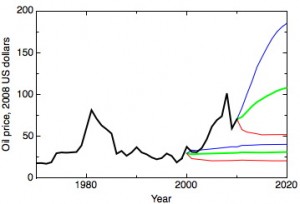The promise of polymer solar cells is that they will be cheap enough and produced on a large enough scale to transform our energy economy, unlocking the sun’s potential to meet all our energy needs in a sustainable way. But there’s a long way to go from a device in a laboratory, or even a company’s demonstrator product, to an economically viable product that can be made at scale. How big is that gap, are there insuperable obstacles standing in the way, and if not, how long might it take us to get there? Some answers to these questions are now beginning to emerge, and I’m cautiously optimistic. Although most attention is focused on efficiency, the biggest outstanding technical issue is to prolong the lifetime of the solar cells. But before plastic solar cells can be introduced on a mass scale, it’s going to be necessary to find a substitute for indium tin oxide as a transparent electrode. But if we can do this, the way is open for a real transformation of our energy system.
The obstacles are both technical and economic – but of course it doesn’t make sense to consider these separately, since it is technical improvements that will make the economics look better. A recent study starts to break down the likely costs and identify where we need to find improvements. The paper – Economic assessment of solar electricity production from organic-based photovoltaic modules in a domestic environment, by Brian Azzopardi, from Manchester University, with coworkers from Imperial College, Cartagena, and Riso (Energy and Environmental Science 4 p3741, 2011) – breaks down an estimate of the cost of power generated by a polymer photovoltaic fabricated on a plastic substrate by a manufacturing process already at the prototype stage. This process uses the most common combination of materials – the polymer P3HT together with the fullerene derivative PCBM. The so-called “levelised power cost” – i.e. the cost per unit of electricity, including all capital costs, averaged over the lifetime of the plant, comes in between €0.19 and €0.50 per kWh for 7% efficient solar cells with a lifetime of 5 years, assuming southern European sunshine. This is, of course, too expensive both compared to alternatives like fossil fuel or nuclear energy, and to conventional solar cells, though the gap with conventional solar isn’t massive. But the technology is still immature, so what improvements in performance and reductions in cost is it reasonable to expect?
The two key technical parameters are efficiency and lifetime. Most research effort so far has concentrated on improving efficiencies – values greater than 4% are now routine for the P3HT/PCBM system; a newer system, involving a different fullerene derivative, PC70BM blended with the polymer PCDTBT (I find even the acronym difficult to remember, but for the record the full name is poly[9’-hepta-decanyl-2,7- carbazole-alt-5,5-(4’,7’-di-2-thienyl-2’,1’,3’-benzothiadiazole)]), achieves efficiencies greater than 6%. These values will improve, through further tweaking of the materials and processes. Azzopardi’s analysis suggests that efficiencies in the range 7-10% may already be looking viable… as long as the cells last long enough. This is potentially a problem – it’s been understood for a while that the lifetime of polymer solar cells may well prove to be their undoing. The active materials in polymer solar cells – conjugated polymer semiconductors – are essentially overgrown dyes, and we all know that dyes tend to bleach in the sun. Five years seems to be a minimum lifetime to make this a viable technology, but up to now many laboratory devices have struggled to last more than a few days. Another recent paper, however, gives grounds for more optimism. This paper – High Efficiency Polymer Solar Cells with Long Operating Lifetimes, Advanced Energy Materials 1 p491, 2011), from the Stanford group of Michael McGehee – demonstrates a PCDTBT/PC70BM solar cell with a lifetime of nearly seven years. This doesn’t mean all our problems are solved, though – this device was encapsulated in glass, rather than printed on a flexible plastic sheet. Glass is much better than plastics at keeping harmful oxygen away from the active materials; to reproduce this lifetime in an all-plastic device will need more work to improve the oxygen barrier properties of the module.
How does the cost of a plastic solar cell break down, and what reductions is it realistic to expect? The analysis by Azzopardi and coworkers shows that the cost of the system is dominated by the cost of the modules, and the cost of the modules is dominated by the cost of the materials. The other elements of the system cost will probably continue to decrease anyway, as much of this is shared in common with other types of solar cells. What we don’t know yet is the extent to which the special advantages of plastic solar cells over conventional ones – their lightness and flexibility – can reduce the installation costs. As we’ve been expecting, the cheapness of processing plastic solar cells means that manufacturing costs – including the capital costs of the equipment to make them – are small compared to the cost of materials. The cost of these materials make up 60-80% of the cost of the modules. Part of this is simply the cost of the semiconducting polymers; these will certainly reduce with time as experience grows at making them at scale. But the surprise for me is the importance of the cost of the substrate, or more accurately the cost of the thin, transparent conducting electrode which coats the substrate – this represents up to half of the total cost of materials. This is going to be a real barrier to the large scale uptake of this technology.
The transparent electrode currently used is a thin layer of indium tin oxide – ITO. This is a very widely used material in touch screens and liquid crystal displays, and it currently represents the major use of the metal indium, which is rare and expensive. So unless a replacement for ITO can be found, it’s the cost and availability of this material that’s going to limit the use of plastic solar cells. Transparency and electrical conductivity don’t usually go together, so it’s not straightforward to find a substitute. Carbon nanotubes, and more recently graphene, have been suggested, but currently they’re neither good enough by themselves, nor is there a process to make them cheaply at scale (a good summary of the current contenders can be found in Rational Design of Hybrid Graphene Films for High-Performance Transparent Electrodes by Zhu et al, ACS Nano 5 p6472, 2011). So, to make this technology work, much more effort needs to be put into finding a substitute for ITO.



